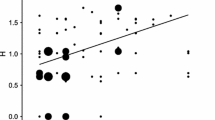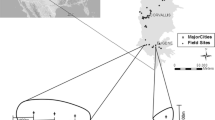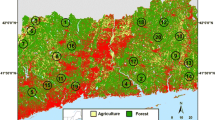Abstract
Fine-scale vegetation cover is a common variable used to explain animal occurrence, but we know less about the effects of fine-scale vegetation heterogeneity. Theoretically, fine-scale vegetation heterogeneity is an important driver of biodiversity because it captures the range of resources available in a given area. In this study we investigated how bird species richness and birds grouped by various ecological traits responded to vegetation cover and heterogeneity. We found that both fine-scale vegetation cover (of tall trees, medium-sized trees and shrubs) and heterogeneity (of tall trees, and shrubs) were important predictors of bird richness, but the direction of the response of bird richness to shrub heterogeneity differed between sites with different proportions of tall tree cover. For example, bird richness increased with shrub heterogeneity in sites with high levels of tall tree cover, but declined in sites with low levels of tall tree cover. Our findings indicated that an increase in vegetation heterogeneity will not always result in an increase in resources and niches, and associated higher species richness. We also found birds grouped by traits responded in a predictable way to vegetation heterogeneity. For example, we found small birds benefited from increased shrub heterogeneity supporting the textual discontinuity hypothesis and non-arboreal (ground or shrub) nesting species were associated with high vegetation cover (low heterogeneity). Our results indicated that focusing solely on increasing vegetation cover (e.g. through restoration) may be detrimental to particular animal groups. Findings from this investigation can help guide habitat management for different functional groups of birds.




Similar content being viewed by others
References
Alexander JD, Seavy NE, Ralph CJ, Hogoboom B (2006) Vegetation and topographical correlates of fire severity from two fires in the Klamath–Siskiyou region of Oregon and California. Int J Wildl Fire 15:237–245. doi:10.1071/WF05053
Allen CR, Holling CS (2002) Cross-scale structure and scale breaks in ecosystems and other complex systems. Ecosystems 5:315–318. doi:10.1007/s10021-001-0075-3
Allouche O, Kalyuzhny M, Moreno-Rueda G, Pizarro M, Kadmon R (2012) Area–heterogeneity tradeoff and the diversity of ecological communities. Proc Natl Acad Sci USA 109:17495–17500. doi:10.1073/pnas.1208652109
Bar-Massada A, Wood EM (2014) The richness–heterogeneity relationship differs between heterogeneity measures within and among habitats. Ecography 37:528–535. doi:10.1111/j.1600-0587.2013.00590.x
Bar-Massada A, Wood EM, Pidgeon AM, Radeloff VC (2012) Complex effects of scale on the relationships of landscape pattern versus avian species richness and community structure in a woodland savanna mosaic. Ecography 35:393–411. doi:10.1111/j.1600-0587.2011.07097.x
Barton PS, Cunningham SA, Manning AD, Gibb H, Lindenmayer DB, Didham RK (2013) The spatial scaling of beta diversity. Glob Ecol Biogeogr 22:639–647. doi:10.1111/geb.12031
Barton P, Ikin K, Smith A, MacGregor C, Lindenmayer D (2014) Vegetation structure moderates the effect of fire on bird assemblages in a heterogeneous landscape. Landsc Ecol 29:703–714. doi: 10.1007/s10980-014-0017-z
Bazzaz FA (1975) Plant species diversity in old-field successional ecosystems in Southern Illinois. Ecology 56:485–488. doi:10.2307/1934981
Benayas JMR, Bullock JM, Newton AC (2008) Creating woodland islets to reconcile ecological restoration, conservation, and agricultural land use. Front Ecol Environ 6:329–336. doi: 10.1890/070057
Benton TG, Vickery JA, Wilson JD (2003) Farmland biodiversity: is habitat heterogeneity the key? Trends Ecol. Trends Ecol Evol 18:182–188. doi:10.1016/s0169-5347(03)00011-9
Bjornstad ON, Falck W (2001) Nonparametric spatial covariance functions: estimation and testing. Environ Ecol Stat 8:53–70
Bonthoux S, Barnagaud J-Y, Goulard M, Balent G (2013) Contrasting spatial and temporal responses of bird communities to landscape changes. Oecologia 172:563–574. doi:10.1007/s00442-012-2498-2
Bradstock RA, Bedward M, Gill AM, Cohn JS (2005) Which mosaic? A landscape ecological approach for evaluating interactions between fire regimes, habitat and animals. Wildl Res 32(5):409–423. doi: 10.1071/WR02114
Brosi BJ (2009) The effects of forest fragmentation on euglossine bee communities (Hymenoptera: Apidae: Euglossini). Biol Conserv 142:414–423. doi:10.1016/j.biocon.2008.11.003
Burnham KP, Anderson DR (2002) Model selection and multimodel inference: a practical information-theoretic approach. Springer, New York
Chessel D, Dufour AB, Thioulouse J (2004) The ade4 package-I-one-table methods. R News 4:5–10
Cliff AD, Ord JK (1981) Spatial processes. Pion, London
Core Team R (2012) R: a language and environment for statistical computing. R Foundation for Statistical Computing, Vienna
Crawley MJ (2002) Statistical computing: an introduction to data analysis using S-Plus. Wiley, West Sussex
De la Montana E, Rey-Benayas JM, Carrascal LM (2006) Response of bird communities to silvicultural thinning of Mediterranean maquis. J Appl Ecol 43:651–659. doi:10.1111/j.1365-2664.2006.01171.x
Dolédec S, Chessel D, Braak CJF, Champely S (1996) Matching species traits to environmental variables: a new three-table ordination method. Environ Ecol Stat 3:143–166. doi:10.1007/BF02427859
DSEWPaC (Department of Sustainability, Environment, Water, Population and Communities) (2013) Fire history of Booderee National Park Jervis Bay Territory. DSEWPaC
Elzinga CL, Salzer DW, Willoughby JW (eds) (1998) Measuring and monitoring plant populations, Denver, CO. US Department of the Interior, Bureau of Land Management, National Applied Resource Sciences Center, Denver
Fischer J, Lindenmayer DB, Montague-Drake R (2008) The role of landscape texture in conservation biogeography: a case study on birds in south-eastern Australia. Divers Distrib 14:38–46. doi:10.1111/j.1472-4642.2007.00411.x
Gandiwa E (2011) Effects of repeated burning on woody vegetation structure and composition in a semiarid southern African savanna. Int J Environ Sci 2:458–471
González-Megías A, Gómez JM, Sánchez-Piñero F (2011) Spatio-temporal change in the relationship between habitat heterogeneity and species diversity. Acta Oecol 37:179–186. doi:10.1016/j.actao.2011.01.011
Gorini L et al (2012) Habitat heterogeneity and mammalian predator–prey interactions. Mammal Rev 42:55–77. doi:10.1111/j.1365-2907.2011.00189.x
Gould WA, Gonzalez G, Carrero Rivera G (2006) Structure and composition of vegetation along an elevational gradient in Puerto Rico. J Veg Sci 17:653–664. doi:10.2307/4096714
Hanspach J, Fischer J, Ikin K, Stott J, Law BS (2012) Using trait-based filtering as a predictive framework for conservation: a case study of bats on farms in southeastern Australia. J Appl Ecol 49:842–850. doi:10.1111/j.1365-2664.2012.02159.x
Holland JD, Fahrig L, Cappuccino N (2005) Body size affects the spatial scale of habitat–beetle interactions. Oikos 110:101–108. doi:10.1111/j.0030-1299.2005.13638.x
Holling CS (1992) Cross-scale morphology, geometry, and dynamics of ecosystems. Ecol Monogr 62:447–502. doi:10.2307/2937313
Holmes RT, Recher HF (1986) Determinants of Guild Structure in Forest Bird Communities: an intercontinental comparison. Condor 88:427–439. doi:10.2307/1368268
Hutchings MJ, John EA, Stewart AJA (2000) The ecological consequences of environmental heterogeneity: 40th symposium of the British Ecological Society. Cambridge University Press, Cambridge
Ikin K, Knight E, Lindenmayer D, Fischer J, Manning A (2012) Linking bird species traits to vegetation characteristics in a future urban development zone: implications for urban planning. Urban Ecosyst 15:961–977. doi:10.1007/s11252-012-0247-2
Ingwersen F (1977) Regeneration of vegetation after fire at Jervis Bay and its implications for management. MSc thesis, Australian National University, Canberra
Jacobsen R (2012) Endangered and threatened wildlife and plants; revised critical habitat for the northern spotted owl. US Fish and Wildlife Service, US Department of the Interior
Jeltsch F, Moloney K, Milton SJ (1999) Detecting process from snapshot pattern: lessons from tree spacing in the southern Kalahari. Oikos 85:451–466. doi:10.2307/3546695
Jin XM, Zhang Y-k, Schaepman ME, Su Z (2008) Impact of elevation and aspect on the spatial distribution of vegetation in the Qilian Mountain area with remote sensing data. The international archives of the photogrammetry, remote sensing and spatial information sciences. Remote Sens Spat Inf Sci 37:1385–1390
Karr JR, Roth RR (1971) Vegetation structure and avian diversity in several New World areas. Am Nat 105:423–435. doi:10.2307/2459511
Katayama N et al (2014) Landscape heterogeneity–biodiversity relationship: effect of range size. PLoS ONE 9:e93359. doi:10.1371/journal.pone.0093359
Khoury F, Janaydeh M, Al-Hmoud A (2009) Nest placement and nesting success in two finch species colonizing a recently established plantation in an arid region. J Ornithol 150:29–37. doi:10.1007/s10336-008-0314-x
Kushla JD, Ripple WJ (1997) The role of terrain in a fire mosaic of a temperate coniferous forest. For Ecol Manage 95:97–107. doi:10.1016/s0378-1127(97)82929-5
Levin SA (1992) The problem of pattern and scale in ecology: the Robert H. MacArthur award lecture. Ecology 73:1943–1967. doi:10.2307/1941447
Leyequién E, de Boer WF, Toledo VM (2010) Bird community composition in a shaded coffee agro-ecological matrix in Puebla, Mexico: the effects of landscape heterogeneity at multiple spatial scales. Biotropica 42:236–245. doi:10.1111/j.1744-7429.2009.00553.x
Lindenmayer DB (2000) Factors at multiple scales affecting distribution patterns and their implications for animal conservation—Leadbeater’s Possum as a case study. Biodivers Conserv 9:15–35. doi:10.1023/a:1008943713765
Lindenmayer DB, Cunningham RB (2011) Longitudinal patterns in bird reporting rates in a threatened ecosystem: is change regionally consistent? Biol Conserv 144:430–440. doi:10.1016/j.biocon.2010.09.029
Lindenmayer D, Hobbs RJ (2007) Managing and designing landscapes for conservation: moving from perspectives to principles. Wiley, Oxford
Lindenmayer DB, Knight EJ, Crane MJ, Montague-Drake R, Michael DR, MacGregor CI (2010) What makes an effective restoration planting for woodland birds? Biol Conserv 143:289–301. doi:10.1016/j.biocon.2009.10.010
MacArthur RH, Horn HS (1969) Foliage profile by vertical measurements. Ecology 50:802–804. doi:10.2307/1933693
MacArthur R, MacArthur JW (1961) On bird species–diversity. Ecology 42:594–598. doi:10.2307/1932254
Martin TE (1993) Nest predation and nest sites. Bioscience 43:523–532. doi:10.2307/1311947
McCullagh P, Nelder JA (1989) Generalized linear models: monographs on statistics and applied probability, 2nd edn. Chapman and Hall, London
McElhinny C, Gibbons P, Brack C, Bauhus J (2005) Forest and woodland stand structural complexity: its definition and measurement. For Ecol Manage 218:1–24. doi:10.1016/j.foreco.2005.08.034
McElhinny C, Gibbons P, Brack C, Bauhus J (2006) Fauna-habitat relationships: a basis for identifying key stand structural attributes in temperate Australian eucalypt forests and woodlands. Pac Conserv Biol 12:89–110
McGranahan DA, Engle DM, Fuhlendorf SD, Winter SL, Miller JR, Debinski DM (2013) Inconsistent outcomes of heterogeneity-based management underscore importance of matching evaluation to conservation objectives. Environ Sci Policy 31:53–60
Montague-Drake RM, Lindenmayer DB, Cunningham RB (2009) Factors affecting site occupancy by woodland bird species of conservation concern. Biol Conserv 142:2896–2903. doi:10.1016/j.biocon.2009.07.009
Morelli F, Pruscini F, Santolini R, Perna P, Benedetti Y, Sisti D (2013) Landscape heterogeneity metrics as indicators of bird diversity: determining the optimal spatial scales in different landscapes. Ecol Indic 34:372–379. doi:10.1016/j.ecolind.2013.05.021
Morrison ML, Marcot BG, Mannan RW (2006) Wildlife-habitat relationships: concepts and applications. Island Press, Washington, DC
Munro N, Lindenmayer D (2011) Planting for wildlife: a practical guide to restoring native woodlands. CSIRO Publishing, Melbourne
Palmer TM (2003) Spatial habitat heterogeneity influences competition and coexistance in an African acacia ant guild. Ecology 84:2843–2855. doi:10.1890/02-0528
Patthey P, Signorell N, Rotelli L, Arlettaz R (2012) Vegetation structural and compositional heterogeneity as a key feature in alpine black grouse microhabitat selection: conservation management implications. Eur J Wildl Res 58:59–71. doi:10.1007/s10344-011-0540-z
Perkins AJ, Whittingham MJ, Bradbury RB, Wilson JD, Morris AJ, Barnett PR (2000) Habitat characteristics affecting use of lowland agricultural grassland by birds in winter. Biol Conserv 95:279–294. doi:10.1016/S0006-3207(00)00042-2
Pianka ER (1972) r and K selection or b and d selection? Am Nat 106:581–588
Reid JRW (1999) Threatened and declining birds in the New South Wales sheep-wheat belt: 1. Diagnosis, characteristics and management. In: CSIRO (ed), Canberra
Rey Benayas J, Bullock J (2012) Restoration of biodiversity and ecosystem services on agricultural land. Ecosystems 15:883–899. doi:10.1007/s10021-012-9552-0
Schoennagel T, Turner MG, Romme WH (2003) The influence of fire interval and serotiny on postfire lodgepole pine density in Yellowstone National Park. Ecology 84:2967–2978. doi:10.1890/02-0277
Specht RL, Specht A (2002) Australian plant communities: dynamics of structure, growth and biodiversity. Oxford University Press, Melbourne
Steffan-Dewenter I, Munzenberg U, Burger C, Thies C, Tscharntke T (2002) Scale-dependent effects of landscape context on three pollinator guilds. Ecology 83:1421–1432. doi:10.1890/0012-9658(2002)083[1421:SDEOLC]2.0.CO;2
Sutherland WJ, Newton I, Green RE (2004) Bird ecology and conservation: a handbook of techniques. Oxford University Press, Oxford
Taws N (1997) Vegetation survey and mapping of Jervis Bay Territory: a report to Environment Australia. Taws Botanical Research, Canberra
Taylor G, Abell R, Jacobson G (eds) (1995) Geology, geomorphology, soils and earth resources. Australian Nature Conservation Agency, Canberra
ter Braak CJF (1986) Canonical correspondence analysis: a new eigenvector technique for multivariate direct gradient analysis. Ecology 67:1167–1179. doi:10.2307/1938672
Tews J, et al. (2004) Animal species diversity driven by habitat heterogeneity of the vegetation: the importance of keystone structures. J Biogeogr 31:79–92. doi:10.1046/j.0305-0270.2003.00994.x
Tyre AJ, Tenhumberg B, Field SA, Niejalke D, Parris K, Possingham HP (2003) Improving precision and reducing bias in biological surveys: estimating false-negative error rates. Ecol Appl 13:1790–1801. doi:10.1890/02-5078
US Fish and Wildlife Service (2011) Revised recovery plan for the Northern Spotted Owl (Strix occidentalis caurina). US Fish and Wildlife Service, Portland
Vanbergen AJ et al (2007) Scale-specific correlations between habitat heterogeneity and soil fauna diversity along a landscape structure gradient. Oecologia 153:713–725. doi:10.2307/40213020
Vikery J, Arlettaz R (2012) The importance of habitat heterogeneity at multiple scales for birds in European agricultural landscapes. Cambridge University Press, Cambridge
Warton DI, Wright IJ, Falster DS, Westoby M (2006) Bivariate line-fitting methods for allometry. Biol Rev 81:259–291. doi:10.1017/s1464793106007007
Weidinger K (2001) Does egg colour affect predation rate on open passerine nests? Behav Ecol Sociobiol 49:456–464. doi:10.1007/s002650100324
Wiens JA (1989) Spatial scaling in ecology. Funct Ecol 3:385–397. doi:10.2307/2389612
Wood EM, Pidgeon AM, Radeloff VC, Keuler NS (2013) Image texture predicts avian density and species richness. PLoS ONE 8:e63211. doi:10.1371/journal.pone.0063211
Zamora J, Verdú JR, Galante E (2007) Species richness in Mediterranean agroecosystems: spatial and temporal analysis for biodiversity conservation. Biol Conserv 134:113–121. doi:10.1016/j.biocon.2006.08.011
Zeng Y, Xu J, Wang Y, Zhou C (2013) Habitat association and conservation implications of endangered Francois’ langur (Trachypithecus francoisi). PLoS ONE 8:e75661. doi:10.1371/journal.pone.0075661
Zuur AF, Ieno EN, Walker NJ, Saveliev AA, Smith G (eds) (2009) Mixed effects models and extensions in ecology with R. Springer, New York
Acknowledgments
We thank the staff and the traditional owners of Booderee National Park for their support and Chris McGregor for logistical assistance. This manuscript was improved by constructive comments from Philip Barton, Annabel Smith and Dejan Stojanovic and two anonymous reviewers. I. S. was funded by an Australian Postgraduate Award. K. I. and P. G. were partly funded by the Environment Decisions Hub of the Australian Government’s National Environmental Research Program. D. B. L. is funded by an ARC Laureate Fellowship.
Author information
Authors and Affiliations
Corresponding author
Additional information
Communicated by Toni Laaksonen.
Electronic supplementary material
Below is the link to the electronic supplementary material.
Rights and permissions
About this article
Cite this article
Stirnemann, I.A., Ikin, K., Gibbons, P. et al. Measuring habitat heterogeneity reveals new insights into bird community composition. Oecologia 177, 733–746 (2015). https://doi.org/10.1007/s00442-014-3134-0
Received:
Accepted:
Published:
Issue Date:
DOI: https://doi.org/10.1007/s00442-014-3134-0




